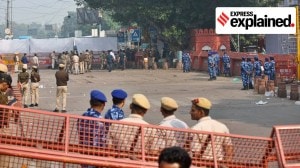Weathering a crisis
With the weather getting unpredictable,farmers in Gorakhpur are looking for ways to save their crops...
No ones doing a countdown to Copenhagen around these parts; if anything,their countdowns have been going all awry. Here,in villages along the trans-Saryu stretch of Gorakhpur,Uttar Pradesh,farmers have been saying that they cant predict the weather any longerfloods come unannounced,summers are longer and winters are bitingly intense. Experts call it climate change but here,like they say in Bhojpuri-Hindi,its simply: mausam mein bahut badlav aa gaya hai (the weather has changed a lot).
These villages,barely three hours from the Indo-Nepal border,are prone to floods due to the swelling of the Saryu,Rapti and Rohin rivers that originate in Nepal. The floods still come but in the wrong months,when the villagers are least prepared,and wash away crops,cattle and homes. Summers and winters are also more intense than ever,they say.
At Makhanaha,a village on the banks of the Rohin river that has a population of 3,421 people,Bhanumati,an elderly farmer,says,Earlier,August was considered the flooding month and wed be prepared for the calamity. But for the last two years,we have seen at least four to five unexpected floods. In 2007,we had a flood around July 30. In 2008,there was one on May 24,and in 2009,a flood hit us in September. There were no floods in August.
Dr Shiraz Wajih,a professor of ecology at Gorakhpur University and founder of the Gorakhpur Environment Action Group,an organisation working on issues of environment and development in approximately 58 villages,says the weather anomalies are due to climate change. There are larger climatic changes occurring across the world and there is climate change at a micro level. Either way,it is bad for development and a serious concern, he says.
More than 90 per cent of people in these villages own less than 1 acre of farmland. These marginal farmers are often forced to migrate to nearby towns as labourers and the wives and children are left to work in the fields, says Wajih.
Villagers complained that the unusually delayed rains this year had ruined their kharif crops and with winter too coming in late,their rabi crops didnt stand much of a chance either.
But now,with some help from government schemes and guidance from NGOs like Oxfam and GEAG,farmers are learning to live with climate anomalies. Farmers are being taught alternative methods of farming,like machan and multiple farming.
Machan and multiple farming are techniques of planting different crops at the same time,so that even if one crop fails,the other yields results. Short-term crops can be reaped quickly, explains Aditi Kapoor of Oxfam India. The state government has also introduced schemes like kisan schools and cattle vaccination programmes to help farmers.



- 01
- 02
- 03
- 04
- 05




























